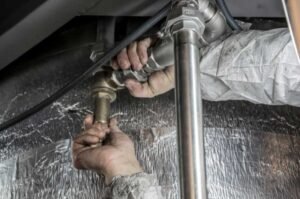6 Effective Methods For Detecting Plumbing Leaks

One of the main and most costly plumbing issues homeowners face is water leaks, notes Stringer Management Specialists. These leaks happen due to clogged lines or damaged pipe joints.
However, many people never realize the leaks, especially when they are underground. Others ignore them, losing much water in the long run. As a result, an average household in the U.S. wastes 10,000 gallons every year, according to the EPA.
If you suspect a water leak in your home, don’t postpone. Take immediate action to avoid costly repairs due to structural damage, high utility bills, and even mold growth, which can lead to diseases.
In this guide, we discuss the top six ways of detecting leakages in your home. Keep reading to learn.
-
Hire a Leak Detection Expert
Although DIYs are cost-saving, some leaks can be hard to find on your own because they need specialized tools. Thus, you need to work with a local licensed plumbing expert to detect hidden leaks before the situation escalates.
For example, if you reside in Ocala and have some plumbing leak issues, always work with the best leak detection Ocala company. This way, you can catch the leaks early using noninvasive techniques and tools like ground detectors and leakage correlators to detect any leak, from wall moisture to sink drips to slab leaks.
-
Use Acoustic Devices
Acoustic devices are one of the most popular methods used to detect leaks. These tools use sensitive microphones that pick up the sounds of water as it makes noise when it leaks under pressure.
You need these special devices because hearing the noise from underground pipes is not easy. The microphone is placed where the leak is suspected and connected to a device that amplifies the sound. If the sound is missed, simply change the position of the acoustic devices.
-
Visual Leakage Detection

Another popular practice is visual detection, which doesn’t involve using complicated devices to identify leaks.
Here, you look for signs of water damage on pipes, which could imply potential water leaks in that area. Plumbers usually use this method when the suspected leakage isn’t underground but in places that are easy to reach or see.
Here’s how this method works.
- Looking for visible water stains and discoloration, which imply the presence of mold due to excess moisture
- Physically checking for water drips in cabinets, under sinks, and other plumbing appliances
- Inspecting the pipes, mainly at the joints, for signs of water leaks
-
Pressure Testing
Pressure testing is an effective practice that tests the areas of the plumbing system that could leak.
Here’s how the method works:
- Identify the target area, which is usually a pipe, and isolate it.
- Close the valves to make it air and watertight.
- After that, pump air or water into the system using a pump and hold it for 10 to 15 minutes. The system is well sealed with no leaks if the pressure doesn’t drop. On the other hand, the system is likely to have leaks when the pressure drops.
Pressure testing works best for newly installed plumbing systems and helps unveil potential leaks when they are still early.
-
Thermal Imaging

Thermal imaging is a technique that uses special cameras to find temperature and detect changes in temperature in different areas. For instance, the cameras can help unveil temperature changes in walls, ceilings, floors, and any other part of the plumbing system where they are placed.
The cameras don’t stay in one place for long. You shift them to different locations to pinpoint the exact areas with a leakage. These special cameras can capture the heat and turn it into an image with unique colors for analysis. For instance, the temperature is considered hot if the pictures are red or yellow. On the other hand, a blue or purple color shows a cold temperature.
-
Dye Testing
This is another effective method of detecting plumbing leakages in different parts of the plumbing systems. It involves using various non-toxic dyes, such as green, blue, orange, or any other easily visible color. You introduce a bright-colored dye part where you suspect a leak.
For instance, you can add the dye to the toilet tank and wait a few minutes. If the dye shows up in the toilet bowl shortly when no one has flushed the toilet, it will be evident that there is a leak in the flush valve. This technique can also be used to detect logs in systems and to identify cross-connections in plumbing systems.
Conclusion
There are many great methods for detecting plumbing leaks, and the above are the most commonly used ones in cities like Ocala.
All methods work well, from physical visual inspection to dye and smoke testing; however, the inspector’s experience matters. Additionally, you need special tools to detect leaks effectively, so working with a professional local plumbing company is wise.
Thus, if you suspect a leak in your plumbing system and don’t want to risk messing up the house or leaks gradually causing property damage, talk to a reputable plumber to help detect and solve problems before they become worse.





